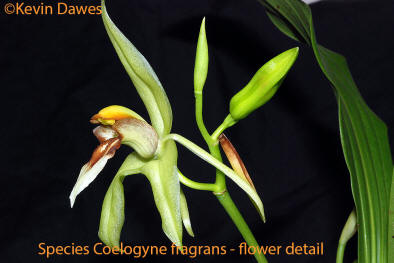Generally well known among orchid growers but not commonly grown, Coelogyne fragrans always evokes attention because of its name and the expectation of beautiful perfume (Mine does not have much perfume !). It is free flowering with erect, neat, open, long-lasting flowers. It comes from a wide range of altitudes in PNG and Irian Jaya from as low as 100m up to 2000m where it grows on trees.
Coelogyne fragrans is reported to hybridise naturally with Coelogyne carinata, both very variable plants anyway. The main distinguishing factor is that Coelogyne fragran's column has more colouring and a distinct orange margin to its column hood. Coelogyne carinata's column tends to be more uniform in colour and lacks the orange. Note the pod (bottom, right) in image above.
Cultivation Suggestions: It is very adaptable but avoid frosts completely. Provide partial shade, lots of humidity and water well. It is hardy and easy to grow in intermediate to warm conditions. The potting mix should be very free draining, as with all epiphytes. Plants that grow on tree trunks or limbs are not likely to ever experience water-logging because they are often attached to a vertical or sloping limb. Many, especially those with thick roots, can absorb water by stretching out into the surrounding moist air. However, if they dry out, it is sometimes difficult to get the roots properly wet as the water will simply run off. In many areas in nature the rain can get near to constant and the debris around the orchid roots will get wet and the aerial roots will absorb lots of moisture.
When applying this to potted orchids, too often they get a splash with the hose, water runs through the bottom of the pot and its time to move on to the next pot. The plant misses out on the hours of constant moisture alternating with drainage. Undoubtedly, the best technique is to soak each pot in a bucket of water for a period (anything up to an hour or longer). If you only have a handful of orchids this is a perfect method. Unfortunately, it's not practical if you have lots of orchids so it becomes necessary to water longer and lighter with a hose to achieve the damp potting mix. Ironically, too often a 'well-watered' orchid dies because in reality it is suffering from drought - the water has run straight through the pot without wetting anything!
A good skill to learn is to be able to judge the weight of the potted plant by lifting it in your hand. I found this seemingly easy and obvious task really difficult at first (and, in my brashness, irrelevant!). Now, I can't recommend this skill highly enough. Practise, practise, practise. Often I lift up a pot on the same day that I have watered and realise it needs more water.
If you have automatic irrigation/sprinkler systems, always do random weight checks as you wander through your collection. Some plants may have been sheltering under a large leaf and missed out on their share of water - especially if using a sprinkler system. Others will be waterlogged because big leaves have funneled extra water into them.
Also check that If a lifted pot feels heavy that it doesn't indicate the potting mix has broken down and become soggy. Tip the plant out of its pot and check the mixture.
The above lifting skill and correct watering is a lot easier to pick up if all your orchids are potted in the same type of mix, in the same size pots, or on similar mounts.
Finally on watering, if you learn the lifting technique you will soon learn how often to water your plants and not need to rely on mindless rules that say 'once a week' or 'every fortnight'.
Negatives: The pale green of the sepals and petals tend to mute the colour of the flower and tend to slide it into a slightly lower group than the more popular large, white flowering, erect Coelogynes.
Rating: ♦♦♦♦ This orchid certainly won't disappoint and should be one put on the shopping list if you have space.
Sometimes sold as: Coelogyne carinata with which it is frequently confused.
Varieties: None known but the flowers show a big range of variation.
Hybrids:
1. Coelogyne Edward Pearce (R Pearce, 1995) - using Coelogyne mooreana as the pollen parent
2. Coelogyne Neroli Cannon (D.M. Cannon, 1981) - using Coelogyne speciosa as the pod parent. I have also remade this hybrid (Coelogyne Neroli Cannon 'Kirribilli') using a more floriferous variation of Coelogyne fragrans.
3. Coelogyne Kirribilli John Davies (Kevin Dawes 2016) using Coelogyne calcicola as the pod parent.
| < Coel flexuosa | Coel huettneriana > |

_small.jpg)